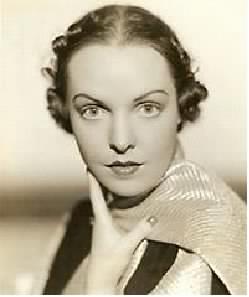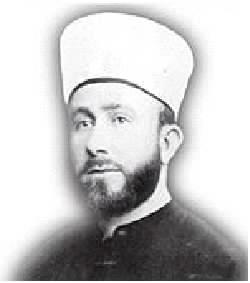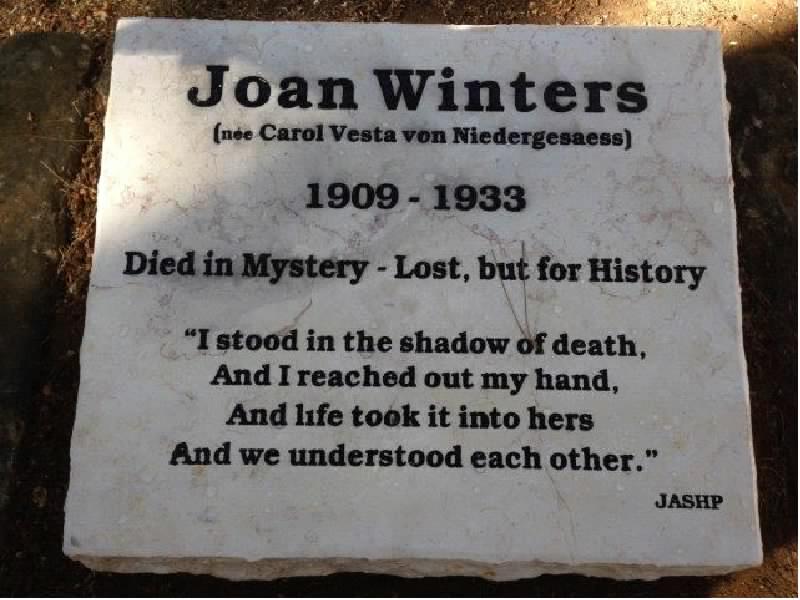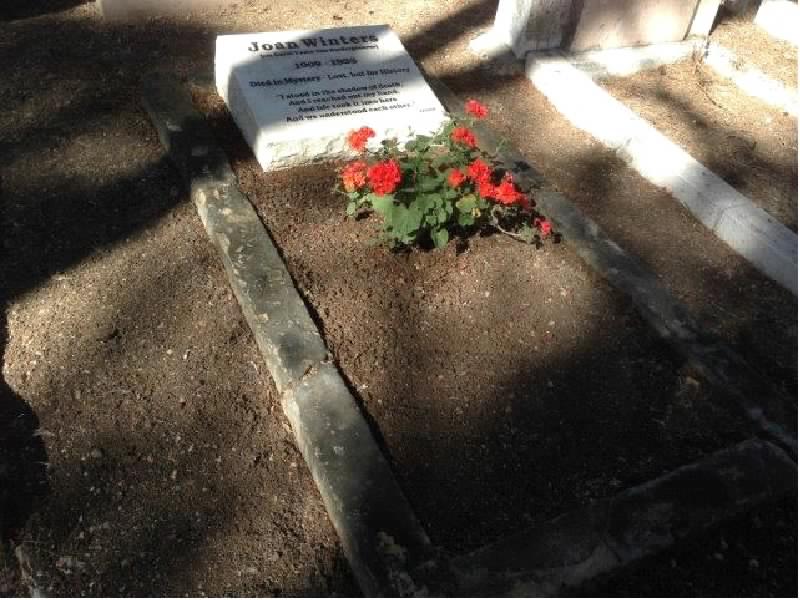| |
July 2014 |
|
| Browse our
|

Joan Winters By Jerry Klinger Robert Avrech, the Emmy Award winning screen writer, wrote about Joan Winters in his blog; that is where I first learned about her. Avrech wrote, her life reads like the plot of a movie. A young, beautiful, restless American showgirl travels to the exotic east where she finds intrigue, romanceand a violent death. Joan was murdered late in October 1933. Her body was found in Jerusalem near the Garden of Gethsemane in an olive grove. It was a frightening time in Jerusalem and all of Palestine. Arab rioting against the Jews and the British had, violently, bloodily, and terrifyingly, flared up again. Winters was almost 24. Joan Winters was not her real name. It was her stage name. Her real name was Carol Vesta von Niedergesaess. She was born in Seattle, Washington, December 8, 1909. Her parents were German immigrants. They ran a small maritime propeller repair business. During the anti-German cultural hysteria the engulfed American society during World War I, even sauerkraut was renamed liberty cabbage. The Niedergesaess thought it best to Americanize their name to Godfrey. Carol Niedergesaess became Carol Godfrey. In 1928, the beautiful, alluring blue eyed young woman moved to New York City to pursue her career as an actress and a dancer. She changed her name again. This time, she became Joan Winters. She must have struggled in the enveloping economic miasma of the developing Great Depression. Yet, she found some success. Joan Winters got a role in a drama centered on the racy theme of female sexuality outside of marriage. She played a supporting character named Sue in a Broadway play titled, appropriately and ironically for her short life, Bad Girl. The play was based upon the book by Vina Delmar, a Jewish feminist and future successful playwright and movie writer. The book was banned in Boston. Joans stage career lasted for 85 performances in 1930. Exactly why Joan decided she had to get away, to travel, is unknown. April 1932, she packed her bags and headed to Europe. She planned to be back in New York for her 24th birthday over a year later in 1934. At least in Europe she had a connection to the movie world. She knew and may have stayed awhile with Mrs. Della Williams, the mother of the famous movie actress, Myrna Loy. Early fall of 1933, Joans wanderlust emerged again. In Athens, Greece, she met a young man, an exotic Indian civil service employee, Mohammad Karamini. He was from Madras. Karamini was traveling with another East Indian Muslim, Mohamed Ikram. Winters father, Bert Godfrey, when asked about the relationship of his daughter to Karamini, vehemently denied that there were any romantic attachments. Joan had hired Karamini to be her tour guide when she traveled East, he said. In Constantinople, Turkey, Winters was arrested by the police. She was accused of being a spy. Held and questioned by Turkish authorities for her unusual traveling arrangements, possibly her Germanic roots though she was an American citizen, the police investigation turned up nothing. Some speculate that the Turkish police suspected her because her father may have had a link to the U.S. military. At best, it is only conjecture. Karamini and Winters were ordered out of Turkey. They sailed for Haifa arriving around mid-October 1933. Disregarding or deliberately ignoring the tensions that had erupted in Jerusalem October 13, the couple traveled immediately to the Holy City. Jerusalem had again been the focal point of an Arab riot incited by the Palestinian leadership and supported by the Grand Mufti, Amin al Husayni. al-Husayni had a long history of incitement, using Jews as his scapegoat. It was a proven, reliable historic pathway to political power. Mohammad Amin al-Husayni Grand Mufti of Jerusalem Early 1920, al-Husayni had been one of the primary instigators of rioting against Jews in Jerusalem. The British wanted to call the Jerusalem attacks by Muslims against Jews as sectarian violence. The Jews were blunter. Menachem Ussishkin, the Zionist leader, called it a pogrom and accused the British of being complicit. Arabs had known of the impending attacks on Jews. The British were warned and did little. The incident that triggered the riots in Jerusalem was when the soccer ball of young Abraham Mizrahi, a Jew, had fallen into a Muslim field. Mizrahi was stabbed to death. Amin al-Husayni was a member of a powerful Muslim clan centered in Jerusalem since the 12th century. They vied for power and control with another powerful Jerusalem centered Muslim clan, the Nashashibis. The Nashashibis settled in Jerusalem in the late 15th century. The Nashashibis were considered the more moderate of the two clans. Both clans struggled against each other, at times bloodily, for power, influence and control. The defeat of the Ottoman Turks ended four hundred years of Ottoman domination over a loosely defined area they called Southern Syria. Both the Husayni and the Nashashibi clans recognized opportunity. The San Remo Treaty between the Great War allies divided the Middle East arbitrarily. Britain was given the Mandate to supervise a newly defined area officially named Palestine. Since the Roman conquest of Israel 1,900 years earlier no nation state had existed in Palestine. The British Mandate for Palestine was to nurture, to steward, the creation of a new State. The San Remo Treaty, and later the League of Nations, recognized Mandate Palestine as the future home for the Jewish people alongside Muslims. Mandate Palestine originally consisted of modern Israel, the West Bank, all of modern Jordan and part of modern Southern Syria. To gain control, al-Husayni needed to expel the British and the Jews. Though reduced to a very small minority, Jews had always lived in Palestine, even after the Roman conquest. Throughout the 19th century, especially the later part of the century when Russian and Eastern European anti-Semitism worsened, more and more Jews returned to their ancient homeland. They were a new type of Jewish immigration. No longer was Jewish immigration just the old religious Jews who wanted to die in the Holy Land. The new Jewish immigrants came to stay and rebuild. They were the Zionists. By the end of the 19th century, Jews were the majority in Jerusalem. For al-Husayni, and many Palestinian Muslims, living under potential Jewish domination was beyond unacceptable. Inciting deep religious prejudice against the Jews, al-Husayni raised the cry - the Jews were going to destroy the Al Aqsa Mosque on the Temple Mount. The British put down the bloody riots of 1920. Al-Husayni fled to exile in Syria. Incredibly, in 1921, the British High Commissioner for Palestine, Sir Herbert Samuel, himself a Jew, sought a formula for peace. He pardoned al-Husayni and appointed him the Grand Mufti of Jerusalem. It was a life time position of religious leadership and control. The choice of al-Husayni was the worst choice possible for peace between Muslim and Jew. From 1921, until he fled Mandate Palestine in 1937 when a warrant was issued for his arrest, al-Husayni did everything he possibly could to bring down the British and the Zionists. His fingers of darkness were deeply interlaced in the bloody Arab riots of 1929, 1933 and the three year war against the Jews and the British, 1936-1939. The British recognized, much too late, that al-Husayni was an enemy. Al-Husayni fled to Nazi Germany where he was openly welcomed by Adolph Hitler. He spent the war years comfortably aiding the Nazis, trying to incite the Muslim World against the Jews and the Allies. Joan Winters, and her travel guide, arrived in Jerusalem precisely at the time when al-Husayni was again trying to incite violence against the Jews and the British. Violence was a tried and repeatedly successful tool of the Palestinian Muslims. Then, and today, violence, or even the threat of violence, is used to impose change in the relations between Muslims and Jews. Repeated attacks and riots convinced the British to renege on the provisions of the Balfour Agreement and the San Remo Treaty with the Jews. Jewish immigration to Mandate Palestine was restricted and then virtually stopped just as Hitler and the Black Clouds of Death from the coming Holocaust embraced European Jewry. The British did not want to antagonize the Palestinian Muslims. It was simpler to restrict Jewish immigration to what they termed, the agricultural absorptive economic capacity of Palestine. The fact was that the vast majority of the Jews of Palestine, and the ones who came seeking refuge, were urban in orientation, not agrarian. The Jews were transforming Mandate Palestine economically. It was a transformation that was beneficial for Arab and Jew alike. It was disruptive to traditional Arab life and the traditional Arab power structure. The year that Joan Winters and Mohammed Karimini arrived in Palestine, Adolph Hitler had become Chancellor of Germany, January 30, 1933. Slightly over 30,000 Jewish refugees made it to Mandatory Palestine and safety. One year after the riots, 1934, the British had accepted Arab fears of Jewish land ownership and economic domination, barely 9,000 Jews made it to Palestine. Death was in the air for Jews. The British closed the door. Al-Husayni and the Palestinian Muslims looked away from the coming human tragedy. Joan Winters and Mohammed Karimini one evening, late in October, went to the Garden of Gethsemane. The next day their bodies were found in a nearby olive grove. Joan had been bludgeoned to death. Karimini had shot in the chest. Neither had been robbed. Winters was not molested. The British Mandate police investigated the murders. They could not devote a lot of police time and attention to the murders. The riots that al-Husayni helped instigate were bloodily working in Jaffa. Jerusalem was comparatively quiet and much of British military and police reserves were sent to Jaffa and other cities where spontaneous demonstrations broke out. The Jerusalem Police concluded that Joan Winters and Mohammed Karimini were victims of the Arab rioting. Joans and Mohammeds traveling companion, Mohammed Ikram, was questioned and released. He made his way to Egypt and quickly back to India and obscurity. The police had suspected a possible rejected lovers act of murderous passion. It was highly improbable that Ikram had killed both Karimini and Winters. Ikram would not have had time to shoot Karimini first and then secure a weapon to bludgeon Winters before she could run away. A more likely possibility was that Winters and Karimini were murders of opportunity in the hate filled days of the 1933 Muslim riots. Their murders were considered unsolved, and remain unsolved murders, to this day. Perhaps Winters was mistaken for a Jew. Perhaps fundamentalists did not approve of a Muslim man and Christian being together. It will never be known. Winters family was notified by the American Consulate of her death in a strange telegram. The consulate needed to know, ASAP, their daughters religion. The family elected not to bring her home. She was buried in the Alliance Church International Cemetery on Emek Refaim. The American Consul General and the Vice Consul General attended the small burial ceremony. That both diplomats should attend the funeral of an obscure American murder victim was unusual. The American State Department did not respond to the requests for help from Winters family. For eighty one years, few came to her grave. The years passed and even fewer knew she was there. She sleeps in one of Israels most important Christian cemeteries. The gates of the Alliance cemetery along busy Emek Refaim Rd. have two large sheet steel, impenetrable barrier gates. The cemetery is in the trendy German Colony area of Jerusalem. It is surrounded by high stone walls hiding or protecting those who sleep within. Inside the cemetery are the graves of Rev. John Stanley Grauel, Charlie Winters (no relation), religious leaders, and important people in Israeli lifehundreds of people rest there. Rev. Grauel, arguably, was the most famous. He was on the Exodus; The Ship that Launched a Nation. The Exodus was a Chesapeake Bay steamer smuggling in 4500 illegal Jewish Holocaust survivors. Even after the War, the British and the Palestinian Muslims refused to permit surviving Holocaust victims a home, a refuge. The British were willing to sink the Exodus in international waters, killing 4,500 people, to stop the ship. Grauels later testimony to the United Nations Special Committee on Palestine changed the course of the U.N.s Partition Resolution. His testimony was given special weight and validity precisely because he was not a Jew. The cremains of Charlie Winters rest in the walls. He served time in an American prison for violating the U.S. embargo against aiding the Jews during the war of Independence with weapons for self-defense. President Bush pardoned him posthumously just before leaving office. There are many other friends of Israel, Christians who loved Israel; Christians who loved Jews, Muslims, and all people. They are buried there. Joan was buried in the Alliance. But no one knew where anymore. Three Jews came together, each in different ways to remember Joan. She died a long time ago. Whether she was religious or not was not the issue. She was a young woman whose life had ended tragically. She deserved to be remembered. Her story, that she had lived, needed to be acknowledged. Robert first told Joans story. Rahel Jaskow located her lost grave in the Alliance. I and my society, the Jewish American Society for Historic Preservation, www.JASHP.org, placed the memorial marker at her gravesite.
Just prior to her death, Joan sent her parents a short enigmatic and prophetic poem. It is carved into her stone. Joan Winters (ne Carol Vesta von Niedergesaess) 1909 1933 Died in mystery lost, but for history I stood in the shadow of death, And I reached out my hand, And life took it into hers, And we understood each other. JASHP She is no longer forgotten.
from the July 2014 Edition of the Jewish Magazine Material and Opinions in all Jewish Magazine articles are the sole responsibility of the author; the Jewish Magazine accepts no liability for material used. |

|
| All opinions expressed in all Jewish Magazine articles are those of the authors. The author accepts responsible for all copyright infrigments. |






